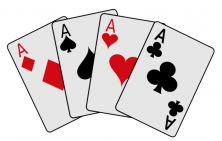Today we are going to learn how to calculate factorials. Calculating factorials is quite simple; let’s see what it’s all about:
What is the Factorial Function?
We represent the factorial function with the exclamation point “!”, placing it after the number. This exclamation means that we need to multiply all of the whole numbers that fall between the number and 1.
For example:
![]()
We generally say “6 factorial”, although it can also be “factorial of 6”.
On your calculator, you’ll see a button with “n!” or “x!”. You can use this button to calculate the factorial of whatever number that you want to calculate.
A Few Examples of Factorials
We’re going to take a look at some more examples of factorials:

As you can see, 100! is a huge number…
And, what do we do with the smaller numbers? 1 factorial is, logically, 1, because it’s simply 1 x 1:
![]()
But, how can we calculate the 0 factorial? Well, when we apply the norms of multiplying all of the whole numbers that fall between 0 and 1, it doesn’t make sense to calculate it because 0 x 1 is 0.
So, the solution is to equate the 0 factorial to 1. So, just remember that:
![]()
What do we use factorials for?
Above all, the factorial numbers are used in combinatorial analysis, in order to calculate combinations and permutations. In a combinatorial analysis, factorials can also be used to calculate probabilities.
We are going to take a look at a simple problem where we can apply factorials.

Paula took out the 4 aces from a deck of cards. She is going to put them in a line on the table. How many different ways could she line them up?
In this problem, we have to solve a “permutation”, or in other words, we have to find out all of the possible ways that these 4 cards can be ordered.
If we start by making all of the possible lines that start off with the ace of diamonds, we can make 6 combinations:
We’ll also have 6 possible combinations with the ace of clubs, heart, and spades. In other words, 6 combinations starting with each one of the 4 aces: 4 x 6 = 24
She could order them in 24 different ways.
Using the factorial function, we could have solved the problem in a much simpler way:
If you start with only one combination of the 4 aces:
- When we choose the first one, there are only 3 left to choose from
- When we choose the second one, there are only 2 left to choose from
- Then when we choose the third one, there is only 1 left to choose from
So as a result, all of the possible combinations are 4 x 3 x 2 x 1.
It’s the same thing as 4! = 24
What did you think about this post? Did it help you understand factorials? If you like math and want to learn more, you can try out Smartick for free by clicking on this link.
Learn More:
- What is Factorial Decomposition?
- Greatest Common Factor (GCF): What It Is and How to Calculate It
- Mathematical Functions: Do You Know What They Are?
- Practice Solving Multiplication Problems
- Learn and Practice Vertical Adding







